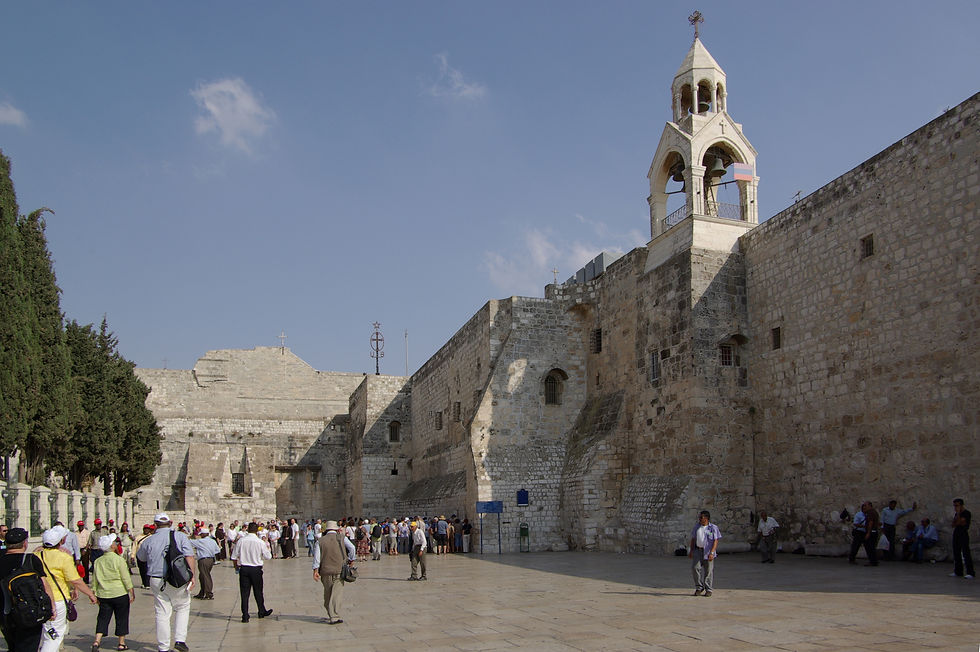“Those who came for the spectacle left instructed in the divine.”[1]
Theodoret of Cyrrhus

The Jews had a handful of holy places worthy of pilgrimage. Most obviously the Temple at Jerusalem (where they were obliged to worship annually) but also the tombs of the prophets, the Terebinths of Mamre at Hebron (Gen. 18:1-8) and Jacob’s Well at Shechem (Gen. 33:18-20) among others. Indeed, some of the early Christians continued the Temple tradition. Peter and John visited for instance (Acts 3:1) as did Paul (Acts 21:6).
Stephen, however, made a (Jewish) criticism of the Temple in Acts 7:47 when he noted the “Most High does not live in houses made by human hands.” Similarly, Christ attacked the veneration of the prophets’ tombs (Mt 23:29). And the Gospel of John sounded the death knell of pilgrimage when it announced “God should not be worshipped in Jerusalem, nor in Gerizim, but in spirit and truth” (Jn 4:21). This was echoed by Justin who claimed the Lord “Was not limited by place;”[2] Clement of Alexandria who noted the “True Temple is the assembly of the faithful;”[3] and Origen who maintained “The only holy place is the pure soul.”[4]
Nevertheless, the early church of Jerusalem kept the memory of Christ alive at a number of Passion sites, most notably his tomb (Mk 16:6), Mt of Olives (where his last meeting with the disciples occurred) and Bethlehem (his birth). These were cherished until AD 135 when the tomb was buried under the rubble of the Capitol, and – rather astonishingly – his site at Bethlehem was incorporated into a grove dedicated to Adonis.[5]
Despite the dearth of holy sites, a sense of intensified sanctity remained. It was simply transferred to the relics of martyrs and bishops. In the mid-second century, for instance, bishop Polycarp’s remains were cherished as “hagion sarkion” (holy remains) which were “timiotera” (more precious) than even jewels or gold, and kept in a place where his martyrdom could be celebrated.[6] This wasn’t an outlandish or isolated move by Smyrna. In fact, if a letter from Polykrates of Ephesos to Victor of Rome is credible then half of Anatolia boasted tombs cum pilgrimage sites.[7] Meanwhile in Carthage, the faithful rather eccentrically laid out cloths to receive Cyprian’s blood before he was martyred.[8]

Back in the Holy Land, Eusebius revealed that locals liked to pray at Gethsemane or get baptised at Bethabara (the site of Christ’s baptism) known as Al-Maghtas in Arabic.[9] While at Rome Constantine probably responded to local fervour when he approved of sanctuaries over the tombs of the city’s martyrs. Later (at Nicaea, 325) he ordered Bishop Makarios of Jerusalem to rediscover the tomb and crucifix of Christ.
Construction works quickly filled the empire and beautified important holy sites, which included the Nativity at Bethlehem, the Anastasis and Martyrium, Golgotha, the Mt of Olives, and Mamre where Abraham’s three visitors (Gen. 18) were traditionally interpreted as a prefiguration of the Trinity. These were continued by Eudokia (wife of Theodosios II) and Justinian. Impressively, lower members of the hierarchy also made attempts at patronage. Bishop John started work on a basilica at Sion. The pilgrim Poemenia commissioned the church of the Ascension. While the patriarch Elias started work on the Nea of the Theotokos.[10]
A major turning point appears to have occurred in the fifth century when the relics of Abbakyros and John were discovered and set up as the opposition to a sanctuary of Menuthis in Egypt.[11] During this period Abu Mena became a major pilgrimage site, as did Sergiopolis in Syria (St Sergios), Seleukeia in Isauria (St Thekla), Ephesos (St John), Chalcedon (St Euphemia), Euchaita (St Theodore), Thessalonike (St Demetrios) and so on. Some holy figures such as St Anthony were so conscious of this trend that they demanded their tombs’ locations be kept secret.[12] Glancing at Antioch’s basilica of Qalat Sem’an (built around Symeon the Elder’s column) or Symeon the Younger’s column and church, it is obvious what vices (pride, celebrity) he was trying to avoid.
Another source of sanctity worth travelling for was angels. Despite being condemned as a residue of Judaism by an important local church, Laodicea on the Lycus (mentioned as one of the seven churches of Asia mentioned in Revelation) in the fourth century, the popularity of angelology in Anatolia rocketed.[13] The regional springboard appears to have been Phrygia (though G. H. R. Horsley & Jean M. Luxford supply detail on this question).[14]

Pilgrimages appear to have been justified in a number of ways but a mainstream argument was that by bringing a sense of place and history into prayer the latter could only be augmented. Chrysostom noted that if you “Visit a martyrium… the sight alone will bring forth tears and a greater fervour in prayer.”[15] Such optimism was tempered by voices like that of Gregory of Nyssa, however, who warned that
“A change of pace does not bring one closer to God… if you are full of evil thoughts even if you are on Golgotha… you are as far from receiving Christ within you as those who have not even begun to confess Him.”[16]
[1] Hist. relig., 26.12.
[2] Passio iustini et sociorum, rec. B, 3; H. Musurillo, Acts of the Christian Martyrs (1972), 48.
[3] Stromata, 8.5.
[4] Homil. In Levit. 3.5.
[5] Epist. 58.3 (CSEL, 54, pp. 531-32).
[6] Passio polycarpi, 18.
[7] Eusebius of Caesarea, Hist. Eccl. 5. 24.5.
[8] Acta Proconsularia Sancti Cyrpriani, 5.4.
[9] Onomasticon 74.17-18, 58.19-20.
[10] Cyril of Skythopolis, Vita Sabae, 72; Prokop. Aed., 5.6.
[11] Sophronios, Miracula cyri et ioannis, 29.
[12] Though Anthony’s was discovered in the sixth century.
[13] Concilium Laodicenum, canon 35 [Mansi].
[14] “Pagan Angels in Asia Minor: Revisiting the Epigraphic Evidence,” Anatolian Studies, Vol. 66 (2016) 141-183.
[15] SS. Mart. Hom. 2 (PG 50:648).
[16] Epist. 2.16-17.
Comments